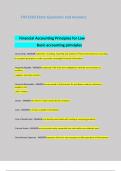Block I and II meeting 1
Padulo paper.
1. According to the authors construction of the force velocity
relationship of human muscles has some differences
/limitations/advantages? compared to work on isolated muscles.
Explain.
There is uncertainty whether the participants deliver maximal stimulation, in
isolated muscle you are sure it is maximal.
When subjects are not familiar with the movement, it is hard to perform it
maximally.
The experiment is in vivo, so you see the entire system at work as a whole you
see the external limits of the entire neuromuscular system during specific
dynamic multi-joint movements.
In vivo there is more variance in the results, while in isolated muscle you will find
similar result every time
2. What execution related factors may affect the outcome of the
force-velocity relationship that they obtain for the squat? Explain
Starting angles are important, because they determine the length of the muscle
which has consequences for the force (length-force relation).
Force-velocity relation also depends on it, because the deeper you do a squat,
the longer the execution will be, the longer you have to reach high stimulation
levels.
3. What does the force measured during the squat (leg-press)
exactly represent? What is the biomechanical equation? How could
you construct a force velocity relation just with the use of a linear
encoder?
It represents the maximal force of the muscle and percentages (load being
pushed away)
F=m*a
- Squat mass = body mass + barbell mass + additional loads
- Leg press mass = body mass + seat mass + additional load *
sine(arctan(10.2deg))
Linear encoder measures linear position. Acceleration is the 2 nd derivative of
position. Weight can be measured beforehand.
4. What force (how is it exactly calculated) is used in the force -
velocity profiles? Is this important, any comments? Alternative
calculations?
(derivative of) displacement & ground reaction force
“The force is the average over each push-off phase determined from the first
change in velocity to the return of force to 0.”
5. What do Fmax and Vmax represent in this study?
The theoretical (by extrapolating) maximal force and maximal velocity of the
lower limb capacities
6. At which percentage of Vmax is power production maximal and
how does this compare to isolated muscle?
Power production is maximal at about 50%, and 30% in isolated muscle.
, 2
In isolated muscle, the maximal velocity is higher than in an experimental
setting, because of segmental dynamics (force lost in rotation of the joints)
, 3
Tahir paper
1. Before opening the Tahir paper: try to produce what the force
traces would look like in relation to changes in muscle length
during the shortening and lengthening experiments they
performed to demonstrate and measure shortening induced force
depression and lengthening induced force enhancement.
2. What is the control measurement to demonstrate that force is
depressed following shortening? And what critical note can you
make in relation to what Tahir did?
Control measurement pure isometric contraction
Critical note you have to know what maximal force is before and
after shortening. So with an isometric measure, so 2 separate tests.
Tahir tested maximal isometric force at L0 immediately before and
after testing, so no separate tests.
3. If we construct a length force relation of isolated
(mouse) muscle. What part of the relation is
presumably affected by titin and why?
Titin contributes to passive tension on the descending limb of the force-length
relationship in myofibrils and muscle fibers. This is due to the fact that as
sarcomeres are stretched, calcium activation increases titin-based force and
stiffness.
Titin stiffness increases upon muscle activation, descending limb is more affected
because titin is lengthened.
4. In what way do the mdm mice differ from wild type and why is this
relevant for the current study?
Titin activation is impaired in muscles from mdm mice. Muscles and single fibers
from mdm mice are passively stiffer and actively more compliant than wild-type
mice.
The study wanted to investigate whether or not titin activation plays a role during
force enhancement (lengthening) and force depression (shortening).
5. What are the differences in isometric force between wild and mdm
mice and why is this important in relation to the effects of stretch
and shortening?
(absolute and relative) isometric force in mdm mice is lower than isometric force
in wild-life mice.
The effect of lower maximum isometric force has to be taken into account when
determining the amount of shortening depression and stretch activation











